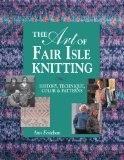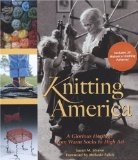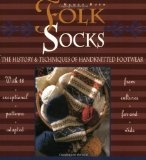-
History of:
- Resources about:
- More:
- Baby walkers
- Bakehouses
- Bed warmers
- Beer, ale mullers
- Besoms, broom-making
- Box, cabinet, and press beds
- Butter crocks, coolers
- Candle snuffers, tallow
- Clothes horses, airers
- Cooking on a peat fire
- Drying grounds
- Enamel cookware
- Fireplaces
- Irons for frills & ruffles
- Knitting sheaths, belts
- Laundry starch
- Log cabin beds
- Lye and chamber-lye
- Mangles
- Marseilles quilts
- Medieval beds
- Rag rugs
- Rushlights, dips & nips
- Straw mattresses
- Sugar cutters - nips & tongs
- Tablecloths
- Tinderboxes
- Washing bats and beetles
- Washing dollies
- List of all articles
Subscribe to RSS feed or get email updates.
Knitters in the Yorkshire Dales around 1850 used...
...a knitting-sheath consisting commonly of a hollow piece of wood, as large as the sheath of a dagger, curved to the side, and fixed in a belt called the cowband. The women of the north, in fact, often sport very curious knitting-sheaths. We have seen a wisp of straw tied up pretty tightly, into which they stick their needles; and sometimes a bunch of quills of at least half a hundred in number. These sheaths and cowbands are often presents from their lovers to the young women. Upon the band there is a hook, upon which the long end of the knitting is suspended that it may not dangle.
William Howitt, The Rural Life of England, 1854
The Art of Fair Isle Knitting: History, Technique, Color & Patterns by Ann Feitelson, from Amazon.comor Amazon UK
Knitting America: A Glorious Heritage from Warm Socks to High Art by Susan M. Strawn, from Amazon.comor Amazon UK

One 'pin' would be tucked into a 'shear' under her arm. These knitting sheaths were made of [cotton] print, small cases a few inches long, and filled tightly with quills - they held one needle, leaving a hand free for quicker movement with the wool. Sometimes a wisp of straw rolled tightly was used instead. Wooden knitting sheaths and sticks were also seen, and the sheaths were occasionally beautifully carved. They were used stuck into, or through the waistband ...
Gladys Thompson, Patterns for Guernseys, Jerseys, and Arans: Fishermen's Sweaters from the British Isles, 1979 edition, first published 1955
Folk Socks: The History and Techniques of Handknitted Footwear, by Nancy Bush, from Amazon.comor Amazon UK

Knitting sheaths & belts
Helping the busy knitter
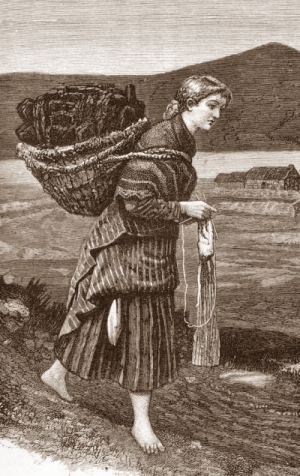 Why
discuss knitting tools on a website about housekeeping, chores, and traditional
"women's work"? Today we see hand-knitting as a hobby, a creative craft practised
in our leisure time, but it used to be an ongoing task, to be fitted in amongst
all the other chores. Families had to be kept supplied with socks, hats, and warm
clothing. Some households stretched their income by making items for sale as well.
Why
discuss knitting tools on a website about housekeeping, chores, and traditional
"women's work"? Today we see hand-knitting as a hobby, a creative craft practised
in our leisure time, but it used to be an ongoing task, to be fitted in amongst
all the other chores. Families had to be kept supplied with socks, hats, and warm
clothing. Some households stretched their income by making items for sale as well.
Many women (and in some places, men) had to work at it every day - except perhaps the Sabbath. And they couldn't always have the luxury of sitting down to knit. They knitted while walking to market, or fetching home fuel (like the peat-carrying woman right), and at many other moments in their busy lives.
 A
knitting sheath or knitting belt made the job faster and easier, especially for
anyone knitting on the move. Put the end of one knitting needle into a holder, which
is fixed at the waist. Now the right needle is kept in position by the sheath, and
the knitter's right hand is freed up to manipulate the yarn more smoothly. (This
requires needles pointed at both ends - see the
video here or
this photo.) One-handed knitting is not impossible.
A
knitting sheath or knitting belt made the job faster and easier, especially for
anyone knitting on the move. Put the end of one knitting needle into a holder, which
is fixed at the waist. Now the right needle is kept in position by the sheath, and
the knitter's right hand is freed up to manipulate the yarn more smoothly. (This
requires needles pointed at both ends - see the
video here or
this photo.) One-handed knitting is not impossible.
Knitting sheaths were familiar in many European countries and in North America, while the knitting belt with pad (see below) seems to have belonged mostly to northern England and Scotland. Use of knitting sheaths declined during the 19th century as industrial machine knitting increased. However, in some areas of the UK, like Yorkshire and Shetland, commercial hand-knitting continued, using traditional sheaths and belts.
Wooden knitting sheaths are quite well-remembered today - perhaps because the well-crafted and/or personalised ones were handed down within families. Some were made by young men as love gifts, and have carved initials, mottoes, or dates. In fact, wooden sheaths were by no means the only kind. (Skip directly to quill and cloth sheaths for more on these half-forgotten but once common knitting aids.)
Wooden knitting sheaths, sticks, or cases
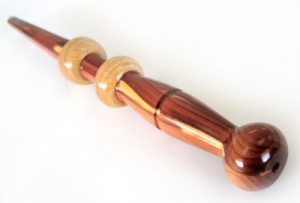 At their simplest, these were just a hollowed-out stick. More elaborate carved sheaths
go back to at least
the 17th century. There has been a revival of interest recently in these,
and some craftsmen are making them for sale. "Goosewing"
types have a curved lower half to fit at the waist. Some had grooves to fit a belt.
The longer types are more likely than others to be called knitting sticks, but names
were regional, and there is no consistent rule about this. Knitting case was another
name.
At their simplest, these were just a hollowed-out stick. More elaborate carved sheaths
go back to at least
the 17th century. There has been a revival of interest recently in these,
and some craftsmen are making them for sale. "Goosewing"
types have a curved lower half to fit at the waist. Some had grooves to fit a belt.
The longer types are more likely than others to be called knitting sticks, but names
were regional, and there is no consistent rule about this. Knitting case was another
name.
- Beamish collection in northern England (website undergoing changes)
- Welsh knitting sticks
- More knitting sheaths in Wales
Knitting belt with pad or pouch
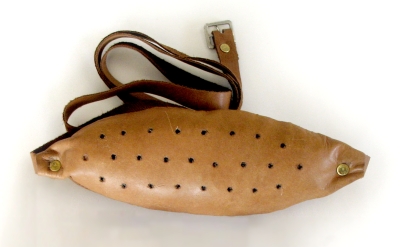 Instead of tucking a rigid sheath into
a waistband, you can use a belt with leather pouch attached. Stuffed with horsehair
and covered with holes where you slot in the needle, this kind of knitting belt
is best known in Shetland where it may be called a makkin (making) or maakin belt.
Children in Shetland schools today are shown how to use one.
Instead of tucking a rigid sheath into
a waistband, you can use a belt with leather pouch attached. Stuffed with horsehair
and covered with holes where you slot in the needle, this kind of knitting belt
is best known in Shetland where it may be called a makkin (making) or maakin belt.
Children in Shetland schools today are shown how to use one.
It was also a traditional tool in other parts of the northern UK: in NE Scotland, for instance. See this knitting belt with needles in position.
When I first remember Filey...[1910, 1920?]...knitting tippies, like those seen in Shetland were worn, these were small leather pouches...one...was pierced with several holes, into one of which the pin was stuck, and held round the waist by a leather band. The Flamborough tippie was a flap of leather pierced by two holes, through which a strong 'bit of band' was threaded and twisted round the long knitting needle...
Gladys Thompson, Patterns for Guernseys, Jerseys, and Arans: Fishermen's Sweaters from the British Isles, 1979 edition, first published 1955
Sheaths made from quills, leather, straw, metal, bone, with or without cloth covers
A common kind of knitting sheath, not often mentioned today, was a goose quill sewn into fabric. They originated in Europe, and seem to have been used in many parts of North America. A goose feather was trimmed to make a tube to hold the needle, and stitched into a cloth holder. This was pinned to the knitter's clothing.
...she may have an ivory knitting-sheath in which the needle is placed. Otherwise she takes two pieces of woolen cloth and sews a narrow slip, large enough to admit a goose quill, and this is pinned to her side...
Mason A. Green, Springfield [Mass.] Memories, 1876
..a knitting sheath was made with a goose quill and a piece of holland linen...
R. P. Hopper, Old-Time Primitive Methodism in Canada, 1829-1884
Knittin-sheth... A quill sewed in a piece of calico or cloth and pinned to the front of the dress to rest the end of one needle in while knitting.
Bennett Wood Green, Word-Book of Virginia Folk-Speech, 1899
"...she said she had to have a knitting quill and they had long since quit using them so mama made her one. ... It was made of a piece of brown jeans cloth. ... There was a piece of goose quill sewed in the center and you pinned the cloth to your lap and stuck one needle in the quill."
Memoirs of Tennessee c1890 (pdf)
Other simple kinds
A tightly tied bunch of straw could serve as a knitting sheath. A bundle of seabird quills was an alternative in coastal areas. This straw 'wisp' was still being used for Fair Isle knitting in the 1920s, though most Shetlanders had gone over to leather knitting belts by 1900. Wisps of straw lent their name to other knitting sheaths and belts called whisks, whiskers etc. A rolled piece of leather was sometimes used, and there were plenty of steel, tin or bone tubes. These could be sewn into a cloth holder.
Abby's parcel contained a new steel knitting sheath, a set of needles, and a large ball of fine yarn.
Story for Christmas Eve, from Sunshine in the Heart - A Book for Girls, 1860
Decorative sheaths
Some of the fancier sheaths were tucked in at the waist, but many came with loops for a ribbon to pin on to clothes, or were even made like a brooch with a jeweller's pin. Some may not have been tough enough for big, heavy pieces of knitting. Others were as good as the more workaday kinds.
- French or Italian fine carving
- Decorative silver knitting heart and fish from the Winterthur Museum
- Dutch silver knitting sheaths
- Portuguese sheath - lead on carved wood
...her gold knitting needles and the gold knitting sheath mounted on black velvet which she wore in the evenings had been given by my father or my grandfather...
Memories of 1826, in Salt Lake City Sunday Herald, 1892
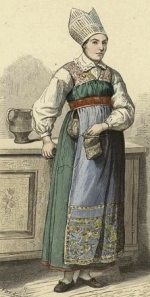 Fabric covers
Fabric covers
Related tools
Knitting sheaths were often used with yarn holders that were also attached to the clothing or tied on with belts etc. These hooks, bags, or baskets were called clew-baskets, clew-hooks etc. in northern England. (Clew, or clue, is a very old word for a ball of thread.) There might also be a hook to hold up larger pieces of knitting and save them from dragging.
 27 Nov 2009
27 Nov 2009
You may like our new sister site Home Things Past where you'll find articles about antiques, vintage kitchen stuff, crafts, and other things to do with home life in the past. There's space for comments and discussion too. Please do take a look and add your thoughts. (Comments don't appear instantly.)
For sources please refer to the books page, and/or the excerpts quoted on the pages of this website, and note that many links lead to museum sites. Feel free to ask if you're looking for a specific reference - feedback is always welcome anyway. Unfortunately, it's not possible to help you with queries about prices or valuation.


